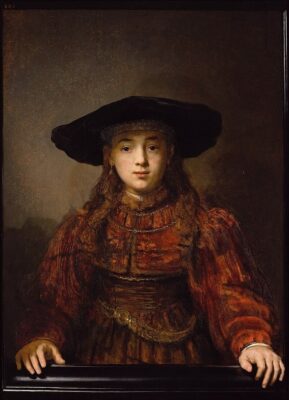2024 Lovis Corinth Colloquium XIII
Art History Department, Emory University
Thursday – Saturday, September 26th – 28th, 2024 Convocation Hall Room 208
The Affective and Hermeneutic Functions of the Mindful Picture
Co-organizers: Walter S. Melion (Emory University) and Michael Zell (Boston University)

1641, oil on panel,
105.5 x 76 cm.
This three-day colloquium examines paintings, drawings, and prints that use various representational contrivances to call attention to their status as pictorial images. Such devices often highlight the mimetic properties of the picture in question, as in the case of ogenbedriegertjes (little eye-deceivers, i.e., trompes-l’oeil), which prompt the viewer to acknowledge that s/he is looking at a pictured picture. A related appliance utilizes elements within the pictorial field—doorkijkjes (optical corridors), gordijnen (feigned curtains), or omlijsten (framing devices, e.g., doorways, casements, archways, stairwells, etc.)—to call attention to the ways in which sight is being mobilized, directed, and/or deflected, as it moves toward a targeted destination. The visual itinerary thus mapped often tracks the viewer’s gaze, whose looking at and into the image is seen to enliven it. More obviously, pictures may contain depicted viewers whose action of beholding doubles that of the actual viewer looking at the painting, drawing, or print, from a vantage point external to it. Handelingh (handling, rendering)—the marks made by a burin, stylus, or brush—can be applied so conspicuously that they compel the viewer to track the marks’ pattern of application: their forceful motion functions as a diagram of sorts for the movement of the viewer’s eyes as they travel along pathways leading in ‘t verschiet (into the distance). Yet another device incorporates portraits into a biblical or mythological scene in which the portrayed subjects are integrated into the story and yet operate apart from it, both temporally and ontologically. There were many other devices, of course. Although scholars of Dutch and Flemish art have duly noted the ubiquity of these and other pictorial means focusing on sight, their affective and interpretative functions have yet to be fully studied. The now common consensus that the reflex of picturing pointedly alludes to vaardigheid (skill) and meesterschap (artisanal mastery) is surely right, but key questions still remain to be answered: when allusions to the viewer’s gaze are coupled with explicit emphasis on pictorial presence of the picturer’s agency, what affects are stirred, what meanings are generated, how, why, and to what end does the bestowal of attention constitute a primary theme or call forth an hermeneutic response. Our colloquium provides a forum for further examination of the form and function of such prompts to affective and hermeneutic engagement with mindful or, to use a term coined by Victor Stoichita, self-aware pictures.
Program: 2024 Lovis Corinth Colloquium XIII